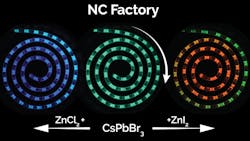Nanocrystal 'factory' could ease perovskite quantum dot manufacturing
Researchers at North Carolina State University (Raleigh, NC) have developed a microfluidic system for synthesizing perovskite quantum dots (QDs) that can flouresce at wavelengths anywhere across the entire spectrum of visible light.1 The system reduces manufacturing costs, can be tuned on demand to any color, and allows for real-time process monitoring to ensure quality control.
Over the last two decades, colloidal semiconductor QDs have emerged as novel materials for applications ranging from biological sensing and imaging to LED displays and solar-energy harvesting. The new system can be used to continuously manufacture high-quality QDs for use in these applications.
"We call this system the Nanocrystal (NC) Factory, and it builds on the NanoRobo microfluidic platform that we unveiled in 2017," says Milad Abolhasani, an assistant professor of chemical and biomolecular engineering at NC State and corresponding author of a paper on the work.
"Not only can we create the QDs in any color using a continuous manufacturing approach, but the NC Factory system is highly modular," Abolhasani says. "This means that, coupled with continuous process monitoring, the system allows modifications to be made as needed to eliminate the batch-to-batch variation that can be a significant problem for conventional QD manufacturing techniques. Additionally, the chemistry we have developed in this work allows the perovskite QD processing to take place at room temperature."
The fluorescence color of QDs is a result of the chemical composition, the size, and the way the nanocrystals are processed. The original QD synthesis strategy utilized in the NanoRobo system allowed for the room temperature synthesis of green-emitting perovskite QDs, which are made using cesium lead bromide. NC Factory starts with cesium lead bromide perovskite quantum dots, but then introduces various halide salts to precisely tune their fluorescence color across the entire spectrum of visible light. Anions in these salts replace the bromine atoms in the green-emitting dots with either iodine atoms (to move toward the red end of the spectrum) or chlorine atoms (to move toward blue).
Halide mixing
The NC Factory system consists of three "plug and play" modules. The researchers developed a premixing module to expedite the mixing of halide salts and QDs to improve product quality. The system also incorporates a velocity sensor that allows users to monitor reaction times accurately. The synthesized QDs are then monitored in situ using the NanoRobo process-monitoring module.
"From a scientific standpoint, the NC Factory system allowed us to discover that this halide-exchange process takes place in three stages," Abolhasani says. "That's very important for better understanding the reaction mechanism. But the system can also impact practical issues related to quantum dot applications and manufacturing."
For example, perovskite QDs are attractive to the solar power industry for their efficiency, but they are still too expensive to be adopted on a large scale. More than 60% of that cost is attributed to manufacturing labor. "The NC Factory system would require far less labor to operate continuously," Abolhasani says. "We estimate that the system could cut overall manufacturing costs by at least 50%. It should reduce manufacturing costs of QDs for any application and should at least preserve—if not improve—the quality of the quantum dots. We've submitted a patent for the system, and are working with industry collaborators to commercialize the technology."
Source: https://news.ncsu.edu/2019/03/nanocrystal-factory-could-revolutionize-quantum-dot-manufacturing
REFERENCE:
1. Kameel Abdel‐Latif et al., Advanced Functional Materials (2019); https://doi.org/10.1002/adfm.201900712
About the Author
John Wallace
Senior Technical Editor (1998-2022)
John Wallace was with Laser Focus World for nearly 25 years, retiring in late June 2022. He obtained a bachelor's degree in mechanical engineering and physics at Rutgers University and a master's in optical engineering at the University of Rochester. Before becoming an editor, John worked as an engineer at RCA, Exxon, Eastman Kodak, and GCA Corporation.

